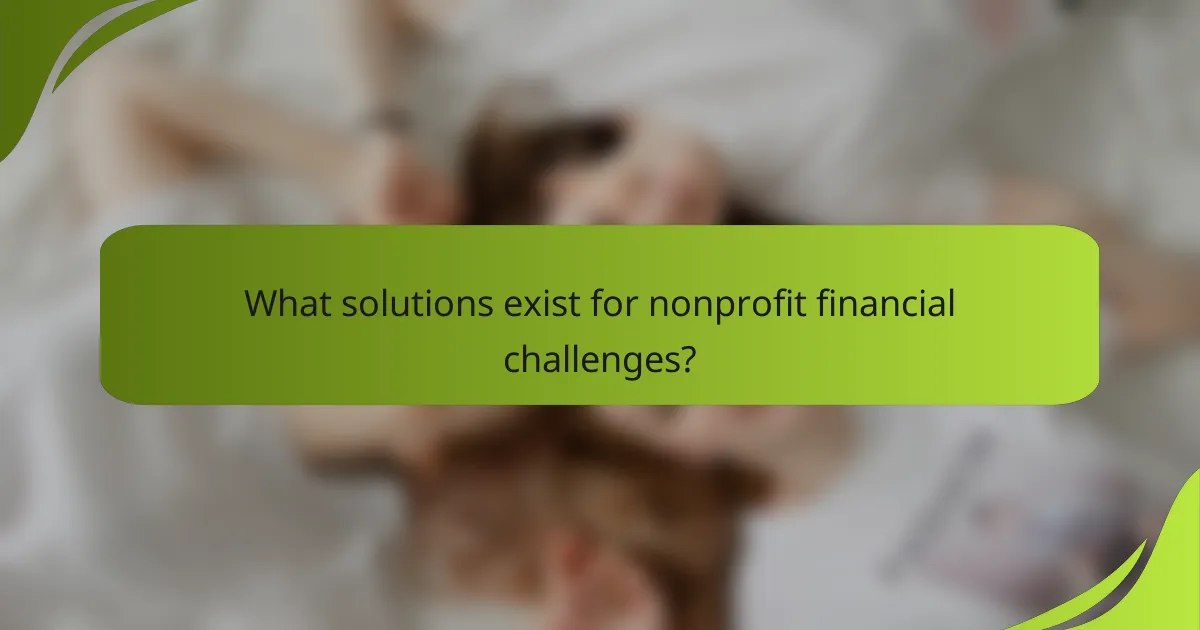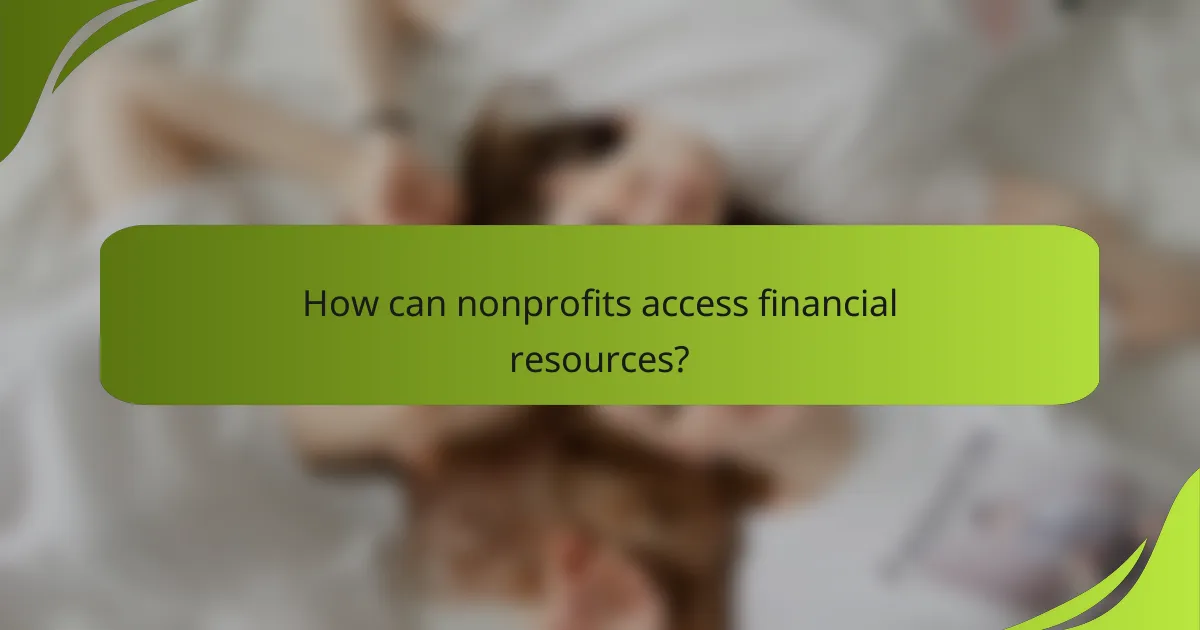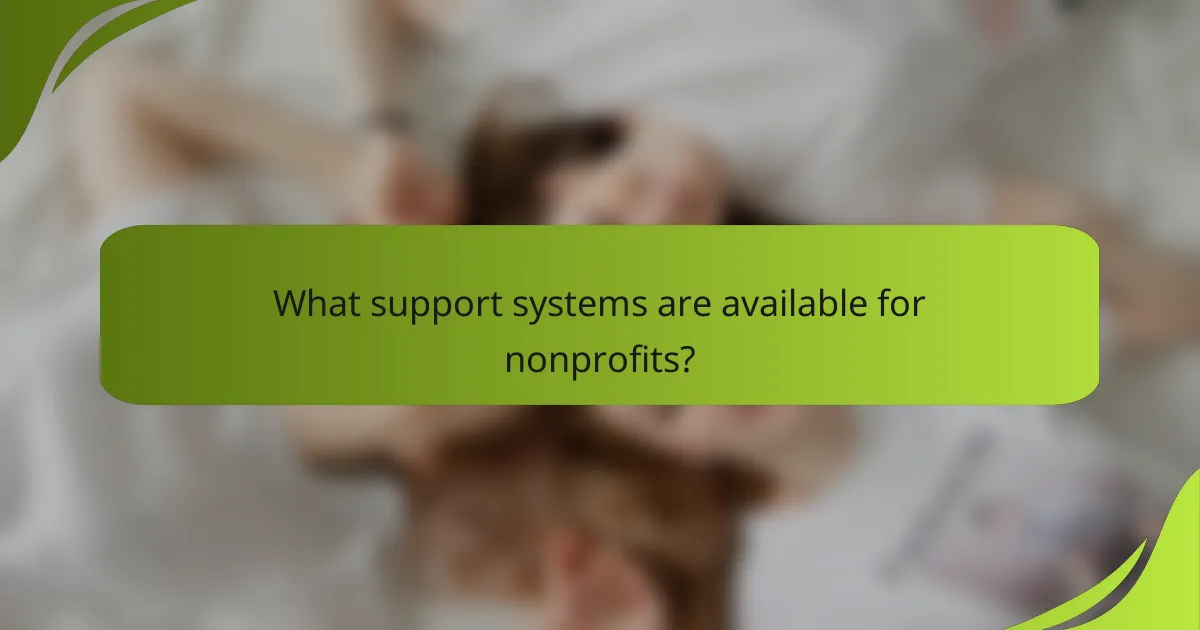Nonprofits frequently face financial challenges that can impede their mission-driven work, such as funding shortages and cash flow issues. To overcome these obstacles, organizations can explore a range of solutions, including grants, fundraising campaigns, and strategic partnerships. Additionally, accessing financial resources through online platforms and community initiatives can provide essential support for sustaining operations and achieving their goals.

What are the financial challenges faced by nonprofits?
Nonprofits often encounter significant financial challenges that can hinder their ability to fulfill their missions. Common issues include funding shortages, cash flow management, and increased operational costs, all of which require strategic solutions to navigate effectively.
Funding shortages
Funding shortages are a prevalent issue for nonprofits, often stemming from reliance on limited sources such as grants, donations, and sponsorships. These organizations may struggle to secure consistent financial support, especially during economic downturns or shifts in donor priorities.
To address funding shortages, nonprofits should diversify their funding sources. This can include exploring new grant opportunities, launching fundraising campaigns, or developing partnerships with local businesses. Establishing a strong online presence can also enhance visibility and attract potential donors.
Cash flow management
Effective cash flow management is crucial for nonprofits to maintain operations and meet financial obligations. Many organizations face challenges in balancing incoming funds with outgoing expenses, which can lead to cash shortages and operational disruptions.
Nonprofits can improve cash flow by implementing robust budgeting practices and regularly monitoring financial statements. Creating a cash reserve can provide a buffer during lean periods. Additionally, setting up a system for timely invoicing and payment collection can help ensure steady cash inflow.
Increased operational costs
Increased operational costs pose a significant challenge for nonprofits, often driven by rising salaries, rent, and program expenses. These costs can strain budgets and limit the funds available for mission-driven activities.
To manage rising operational costs, nonprofits should regularly review their expenses and identify areas for potential savings. This might involve renegotiating contracts, seeking in-kind donations, or utilizing volunteers to reduce labor costs. Implementing technology solutions can also streamline operations and improve efficiency, ultimately lowering expenses.

What solutions exist for nonprofit financial challenges?
Nonprofits can address financial challenges through various solutions, including grants, fundraising campaigns, and partnerships with local businesses. Each option offers unique benefits and considerations that can help sustain operations and support missions.
Grants from foundations
Grants from foundations are a significant source of funding for nonprofits. These funds are often awarded based on specific criteria, such as project impact or alignment with the foundation’s mission. Nonprofits should research potential foundations and tailor their proposals to meet their requirements.
It’s essential to track application deadlines and maintain relationships with grantors. Many foundations prefer to fund projects rather than general operating expenses, so clearly defining the project’s goals and expected outcomes can enhance the chances of receiving funding.
Fundraising campaigns
Fundraising campaigns can effectively generate revenue for nonprofits. These campaigns can take various forms, including events, online crowdfunding, or direct mail appeals. Setting clear goals and timelines for fundraising efforts is crucial for success.
Nonprofits should consider leveraging social media and email marketing to reach a broader audience. Engaging storytelling about the organization’s mission can inspire potential donors. Additionally, offering incentives, such as recognition or small gifts, can motivate contributions.
Partnerships with local businesses
Forming partnerships with local businesses can provide nonprofits with additional resources and support. These collaborations can include sponsorships, in-kind donations, or joint events that benefit both parties. Establishing a mutually beneficial relationship is key to successful partnerships.
Nonprofits should approach businesses that align with their mission and values. Clear communication about the benefits of the partnership, such as increased visibility for the business and community goodwill, can help secure support. Regular updates and recognition of contributions can strengthen these relationships over time.

How can nonprofits access financial resources?
Nonprofits can access financial resources through various channels, including online fundraising platforms, government funding programs, and community support initiatives. Each option offers unique benefits and considerations that can help organizations secure the funding they need to operate effectively.
Online fundraising platforms
Online fundraising platforms enable nonprofits to raise money through digital campaigns. These platforms, such as GoFundMe, Kickstarter, and JustGiving, allow organizations to create tailored fundraising pages and share them widely through social media and email.
When choosing a platform, consider fees, ease of use, and the ability to integrate with existing systems. Many platforms charge a percentage of the funds raised, typically ranging from 5% to 10%, so it’s essential to evaluate the cost against potential benefits.
Government funding programs
Government funding programs provide grants and financial assistance to nonprofits for specific projects or operational support. In the U.S., for example, organizations can apply for grants through federal agencies like the National Endowment for the Arts or local state programs.
To access these funds, nonprofits should research eligibility criteria, application processes, and deadlines. Many grants require detailed proposals and budgets, so having a clear plan and financial documentation is crucial for success.
Community support initiatives
Community support initiatives often involve local businesses, foundations, or civic organizations that provide funding or resources to nonprofits. These initiatives can include sponsorships, in-kind donations, or collaborative projects that benefit both the nonprofit and the community.
Engaging with local stakeholders and building relationships can enhance a nonprofit’s visibility and access to resources. Consider hosting community events or outreach programs to foster connections and encourage support from local entities.

What support systems are available for nonprofits?
Nonprofits can access various support systems to enhance their financial stability and management. These resources include consulting services, workshops, and networking opportunities that cater specifically to the unique challenges faced by nonprofit organizations.
Nonprofit financial consulting services
Financial consulting services for nonprofits provide expert guidance on budgeting, fundraising strategies, and financial reporting. These consultants often have experience in the nonprofit sector and can help organizations navigate complex financial landscapes.
When selecting a consulting service, consider their track record with similar nonprofits and the specific areas where you need assistance. Many consultants offer tailored packages, so it’s beneficial to discuss your organization’s unique needs upfront.
Workshops on financial management
Workshops focused on financial management equip nonprofit leaders with essential skills in budgeting, accounting, and financial planning. These sessions often cover practical topics such as grant writing and effective fundraising techniques.
Look for workshops offered by local nonprofit associations or community colleges, as they may provide valuable insights at low or no cost. Participating in these workshops can also foster collaboration and idea-sharing among attendees.
Networking opportunities with other nonprofits
Networking opportunities allow nonprofits to connect with peers, share experiences, and collaborate on projects. These interactions can lead to partnerships that enhance funding opportunities and resource sharing.
Consider joining local nonprofit networks or attending conferences to expand your connections. Engaging with other organizations can provide insights into best practices and innovative solutions for common financial challenges.

What criteria should nonprofits consider when seeking funding?
Nonprofits should evaluate several key criteria when seeking funding, including eligibility requirements, funding timelines, and reporting obligations. Understanding these factors can help organizations identify suitable funding sources and effectively manage their resources.
Eligibility requirements
Eligibility requirements often vary by funding source and can include factors such as organizational type, mission alignment, and geographic location. Many funders prioritize nonprofits that serve specific communities or address particular issues, so it’s crucial to review these criteria carefully.
For example, some grants may only be available to 501(c)(3) organizations in the United States, while others might focus on local initiatives. Nonprofits should ensure they meet all eligibility criteria before applying to avoid wasting time and resources.
Funding timelines
Funding timelines can significantly impact a nonprofit’s ability to plan and execute projects. Each funding source has its own schedule for application deadlines, review periods, and disbursement of funds, which can range from a few weeks to several months.
Nonprofits should create a timeline that aligns with their project needs and the funding cycles of potential funders. Staying organized and aware of these timelines can help avoid missed opportunities and ensure timely project implementation.
Reporting obligations
Reporting obligations are essential for maintaining transparency and accountability with funders. Most grants require regular updates on project progress, financial expenditures, and outcomes achieved, which can vary in frequency and detail.
Nonprofits should familiarize themselves with the specific reporting requirements of each funding source. This includes understanding what metrics to track and the format for reporting, as failing to meet these obligations can jeopardize future funding opportunities.

How do economic trends impact nonprofit funding?
Economic trends significantly influence nonprofit funding by affecting both the availability of donations and the financial health of potential donors. Factors such as inflation, unemployment rates, and economic growth can alter donor behavior and the overall funding landscape for nonprofits.
Impact of inflation on donations
Inflation can reduce the purchasing power of individuals and businesses, leading to decreased disposable income for charitable giving. As prices rise, potential donors may prioritize essential expenses over discretionary spending, including donations to nonprofits.
Nonprofits may experience a decline in both the number of donations and the average donation size during periods of high inflation. For example, if inflation is around 5-10%, donors might cut back on their contributions, resulting in a significant impact on nonprofit budgets.
To mitigate the effects of inflation, nonprofits should consider adjusting their fundraising strategies. This could involve emphasizing the immediate impact of donations, engaging in targeted outreach to loyal donors, and exploring new funding sources such as grants or corporate partnerships that may be less sensitive to economic fluctuations.


